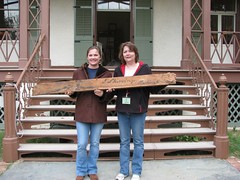Introduction by Erin Carlson Mast
Contributed by David Rotenstein
Previous research indicated that John Skirving was the architect of the veranda on George W. Riggs’s house, which later became President Lincoln’s seasonal residence, and that Skirving’s influence was limited to that portion of the building. Through the research of Dr. David Rotenstein, it is now evident that Skirving was responsible for the architectural design of more of the Cottage built for George W. Riggs Jr. in 1842 than previously thought.
 As part of his research, Rotenstein located and contacted descendants of John Skirving, Ms. McLaughlin of Ohio and Ms. Herold of South Carolina. McLaughlin and Herold visited President Lincoln’s Cottage this past weekend to see the work of their great-great-great grandfather.
As part of his research, Rotenstein located and contacted descendants of John Skirving, Ms. McLaughlin of Ohio and Ms. Herold of South Carolina. McLaughlin and Herold visited President Lincoln’s Cottage this past weekend to see the work of their great-great-great grandfather.
What follows is a modified excerpt from Dr. Rotenstein’s paper, “John Skirving, Capital Craftsman.”
John Skirving was an architect, artist, engineer, and entrepreneur who came to Washington in the winter of 1839 to heat and ventilate buildings under construction by the federal government. Recognized by his contemporaries as a competent mechanic and skilled designer, Skirving made enduring and wide-ranging contributions to Washington’s built environment and the nation’s aesthetics during the mid-nineteenth century. He is mainly known as a footnote to the architectural history of the farmhouse built for banker George W. Riggs Jr. that has gained fame as President Lincoln’s Cottage on the grounds of the Armed Forces Retirement Home.
In 1842 Skirving became involved with Washington carpenter William H. Degges and the son of a District brickmaker and bricklayer in the design and construction of a new farmhouse for George W. Riggs Jr. The collaboration came near the end of the depression and it was made possible by the bankruptcy of John Agg, a Riggs family friend. In June 1842, Riggs bought Agg’s farm in the hills overlooking Washington and the following month the banker hired Degges to design and build a new house. Degges drew up the “Specifications of materials and workmanship, of a house to be built for Geo. W. Riggs on his farm near Rock Creek Church.”[1] The July 23, 1842 specifications called for a two-story brick house. All carpentry and masonry work was detailed, from the width of each wall to the types of brick, wood, glass, and hardware to be used. One brief passage in the three-page document provides the sole surviving documentary link between Degges and Skirving: “Verandah on South side according to plan given by M John Skirving.” [2]
While Degges was a competent builder, he lacked Skirving’s experience and skills in architectural and landscape design. American architectural pattern book authors like Alexander Jackson Davis and Andrew Jackson Downing relied heavily on the aesthetics and vocabulary of the built environment popular in England during the first half of the nineteenth century.[3] In Skirving, Degges and Riggs had a living thread tied to the source of the contemporary domestic architects popularizing and adapting English templates to the American landscape.[1] William H. Degges, “Specifications of Materials & Workmanship, of a House to Be Built for Geo. W. Riggs on His Farm Near Rock Creek Church, Formerly the Property of M Agg,” 23 July 1842. Library of Congress. Manuscript Division, Riggs family papers, 1763-945, Business Papers, George W. Riggs, Jr., 1836-1852. Container 67.
[2] Degges, “Specifications of Materials & Workmanship, of a House to be Built for Geo. W. Riggs on his Farm near Rock Creek Church, Formerly the property of M Agg.”
[3] Dell Upton, “Pattern Books and Professionalism: Aspects of the Transformation of Domestic Architecture in America, 1800-1860,” Winterthur Portfolio 19, no. 2/3 (Autumn 1984): 107-50. While Downing was an unlikely source of Skirving’s design aesthetic in the early 1840s, pioneering English landscape architect John Claudius Loudon may have been accessible and influential to Skirving.
Dr. Rotenstein’s complete paper on John Skirving is available here: John Skirving, Capital Craftsman by David S. Rotenstein
